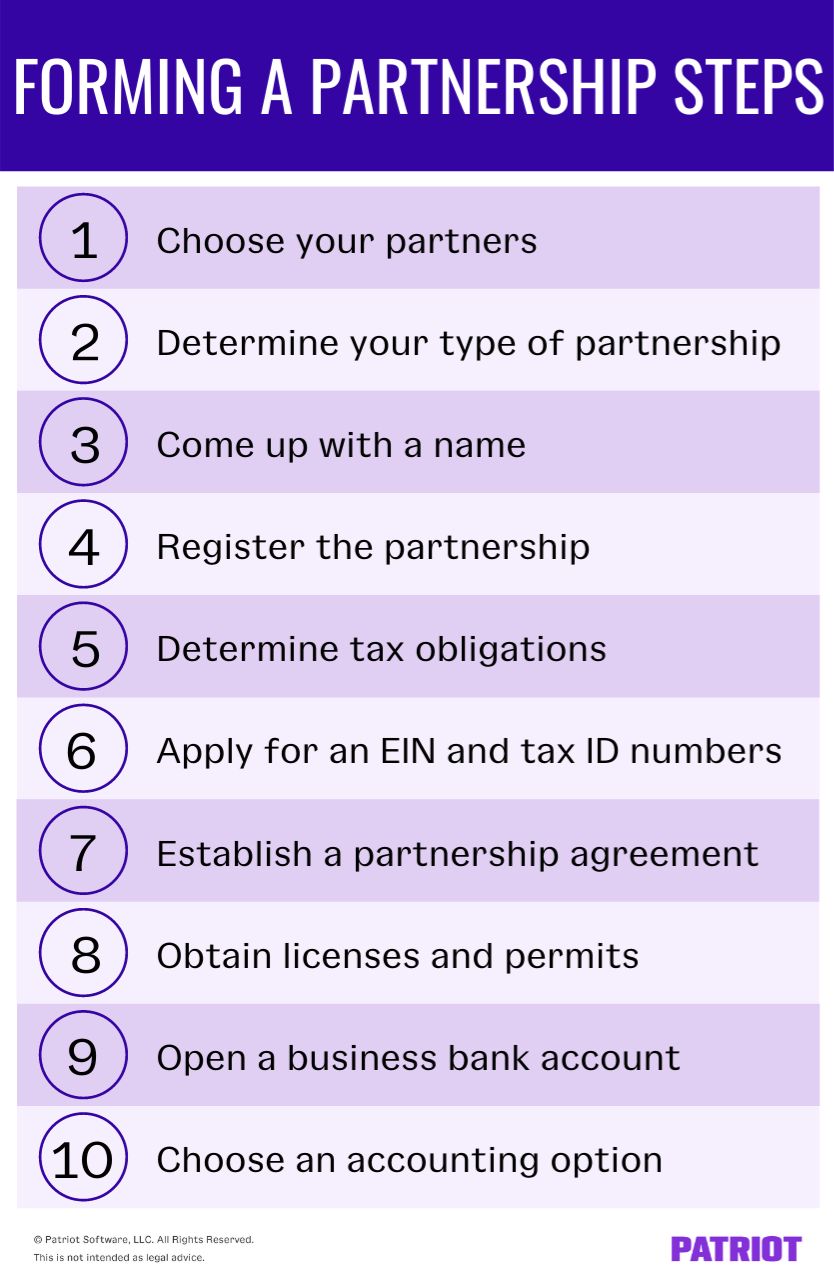When you start a business, you have to determine whether you are going to call the shots by yourself or have a co-owner. If you’re not too keen on the idea of running a business solo, you may consider starting a partnership. Find out how to form a partnership to get the ball rolling on your business venture.
Partnership overview
So, what is a partnership, anyway? Well, the word “partner” in partnership is probably a dead giveaway. But, let’s briefly recap what a partnership entails.
A partnership is one of the many different types of business structures. It is a company that two or more individuals own and operate together. There are many types of partnerships you can establish, which we will discuss later.
Partnerships have pass-through taxation. Pass-through taxation is when the business taxes “pass through” the business onto another entity, like a business owner. Instead of the business paying the taxes, the partners do.
How to form a partnership: 10 steps to success
To form a partnership, you have to have patience, be willing to compromise, and do plenty of homework. Are you ready to get started? Learn how to form a business partnership by following the 10 steps below.

1. Choose your partners
When it comes to starting a partnership, you have to choose your partner(s) wisely. After all, you’re going to be working with them closely.
Take your time when choosing your partner or partners. While searching for a partner, look at things like:
- Skills and strengths
- Knowledge
- Credibility
You’ll likely also want to pick a partner who is financially stable, shares the same vision as you, and can offer resources for the partnership (e.g., industry connections).
Don’t rush into a decision when selecting your partner. Ask yourself questions like, What do they bring to the table? Will we get along? Do we share the same values? The longer you ponder on these questions, the better.
2. Determine your type of partnership
As mentioned, there are multiple types of partnership to choose from. They include:
- Limited partnership
- General partnership
- Limited liability partnership
- LLC partnership
Each type of partnership has its own pros and cons. Discuss the types of partnerships with your partner(s) to determine which one is the best fit.
3. Come up with a name for your partnership
After you determine your partnership type, flex your creative muscles by choosing a name for your partnership.
Your business name may incorporate the names of the partners (e.g., Miller & Brown). Or, it might not include the partners’ names (e.g., Lake City Jewelry)
Depending on your partnership type, you may need to include a combination of the partners’ names in your business name. For example, if you are an owner of a general partnership, the business name is generally a combination of the owners’ last names.
After coming up with a business name, check to make sure that it is not already taken by another business. You can search the name online, check domain names, and run a trademark search.
Some states also have requirements for partnership names. Do your research and contact your state before moving forward with a name for your partnership.
4. Register the partnership
After you come up with your partnership’s business name, it’s time to register with your state.
In most cases, you can register your business online through your state’s Secretary of State website.
If your partnership will be doing business in more than one state, you must register with each state. You have a domestic partnership in your main state and a foreign partnership in all other states.
Consult your Secretary of State if you have questions about registering your business with your state.
5. Determine tax obligations
Part of your responsibilities as a co-owner of a partnership is to handle business taxes. Each business entity must file and pay taxes regularly (e.g., quarterly). To ensure you are compliant, find out what your tax obligations are.
Partnerships file business tax returns using Form 1065, U.S. Return of Partnership Income. Report profit and losses to the IRS using Form 1065. Form 1065 is due on the 15th day of the third month after the partnership’s tax year ends.
Each partner must also use Schedule K-1 to fill out their individual tax returns. Distribute Schedule K-1 to partners by March 15 each year. Partners must file Schedule K-1 by April 15.
6. Apply for an EIN and tax ID numbers
Again, you’re responsible for paying taxes on your partnership’s income and reporting it to the government. But in order to do that, you need to apply for tax ID numbers and an Employer Identification Number (EIN).
Depending on your business and location, you may need to apply for the following:
- Federal tax ID number
- EIN
- Business tax ID number (e.g., permits)
- State tax ID number
- Local tax ID number
To find out what identification numbers you need to obtain, contact the IRS, your state, and your locality.
7. Establish a partnership agreement
When you create a partnership, you need to narrow down roles, responsibilities, and liabilities. To do that, you and your partners must establish a partnership agreement.
A partnership agreement is a legally-binding contract that lays out each partner’s role, liability, and profit distribution. You can refer to your agreement during conflict and use it to find resolutions.
Agreements vary from business to business and typically depend on the type of partnership you form.
You’re not required to create a partnership agreement. However, if you decide not to make one, you must still follow your state’s partnership laws.
If you need help with creating a partnership agreement or have questions about it, consult a small business lawyer.
8. Obtain licenses and permits, if applicable
Before you can begin operating, you may need to obtain certain licenses and permits, depending on state and local requirements.
Some types of permits and licenses you may need to get include a business license, sales tax permit, resale certificate, DBA license, building permit, or industry-specific license.
Check with your state and locality to find out which licenses and permits you need to obtain for your partnership.
9. Open a business bank account
As a business owner, the last thing you want to do is mix business and personal funds together and cause confusion for your co-owner(s). To keep your partnership’s finances in tip-top shape, create a separate bank account for business.
To open a business bank account for your partnership, you need your:
- EIN
- Partnership agreement
- Business name filing document (e.g., DBA form)
Depending on your banking institution, you may also need to provide additional information or documents to open an account.
10. Choose an accounting option
Last but certainly not least, you and your partners need to decide which route you’re going to take for managing your books. You can:
- Manually record transactions
- Use accounting software
- Hire a bookkeeper
Manually recording transactions is a great option if you’re on a budget and looking to save a few bucks. However, it is more time-consuming than other accounting options. Not to mention, you have to familiarize yourself with accounting terms and practices.
Hiring a bookkeeper gives you the peace of mind knowing that your books are in good hands and are accurate. But, it is the most expensive option out of the bunch.
Accounting software is a happy medium. Software is more affordable and helps you streamline accounting processes so you can get back to your business. You can also use software in conjunction with using a professional. With software, you can hand your organized documents to your accountant, lowering your total bill.
Whichever route you take, make sure you have a way to track and manage your books. The last thing you want to do is wind up with sloppy and inaccurate books.
Need an easy way to track your business’s income and expenses? Patriot’s online accounting software lets you streamline the way you record transactions and organize your books. Try it for free today!
This is not intended as legal advice; for more information, please click here.
